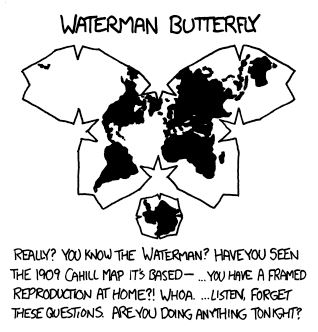Not related, but did you ever use k9s? Quite nifty CLI tool to control Kube, albeit not on a very advanced level, it helped me a lot to not get drowned in Kube commands.
Derpgon
- 1 Post
- 1.14K Comments
With 4, you are correct, I went from top of my head back what we learned in high school 15 or so years ago. 5 is still better than nothing if you don’t have the resources to get one more drive for 6. Of course, the best is completely mirroring all stuff to a separate geo location.
It all boils down to willingness of spending money for more durability.
I’ve edited my comment to scratch R4. But R5 is still great for smaller arrays, and it is possible to, for example, have RAID 5 for movies, and RAID 6 for photos.
There are also combinations of RAID levels, like aforementioned 10. There is a nice comparison table with apparent drive requirements and fault tolerance on Wikipedia: https://en.m.wikipedia.org/wiki/Standard_RAID_levels
You’ll have to find some kind of balance, ad it js a game of chance. You are always limited by number of slots in your server and current largest drive size. Then you are trying to balance price, speed, and durability.
For exampl, let’s say maximum amount of drives is 10, and maximum manufactured size is 50 TB. You probably don’t need 500 TB of storage that is in no way durable (if a drive dies, all the data on it is lost) and on a single server.
Death of drives is almost certain, two drives dying at the same time is quite low, so something like RAID
4,5, 6, or 10 is a great start. Depends on how much storage you want, and then partition it accordingly. If you want 20 TB, you can do 4x 8TB in RAID 5, which yields 3x 8TB (=24) of effective storage.Adding new drives is easy, and you are are always wasting just one drive. Then it depends if you want to sacrifice more space for more durability and switch to RAID 6 later on.
If you want even more storage, you can buy a micro server like ODROID H4+ and use it as network connected storage.
Holy, never knew, and never would expect. Postgres truly is king.
Mysql can too, slow af tho.
It shouldn’t be used as a marketplace, it should be used as a repository. You can probably find a lot of malware on GitHub, doesn’t mean you go there to choose your text editor.
I never search the AUR directly, I only use it if some README tells me I can install their software via an AUR package.
Mysql / Mari can handle it too! Just use BLOB 🤣
Jira would be okay without needless amount of plug-ins, extensions, and dumb workflows one has to follow. Accidentally put it in the wrong state? Enjoy writing to someone who can fix it. Besides, it is slow as fuck and is getting slower with all the tickets (over 80k on our instance) it has to track. Search is shit, and it is shoving AI in my face on every step.
Plain Jira is not bad. In my second company that I work for, I set up OpenProject and it has been working flawlessly for about 5 years already, it can easily track GitLab commits, branches, and merge requests, and do basic time tracking. It has some nifty features like “budget users” when you want to do budgeting with a “ghost user”.

 2·22 days ago
2·22 days agoIt’s always 1 a day, then 2, then a pack, and then 2. Not talking from personal experience, but the body naturally builds up tolerance.
The trick is to rotate addictions weekly ;)

 1·22 days ago
1·22 days agoIt’s always 1 a day, then 2, then a pack, and then 2. Not talking from personal experience, but the body naturally builds up tolerance.
The trick is to rotate addictions weekly ;)

 1·22 days ago
1·22 days agoLiterally, yes. However you so not use this wording in natural language.

 3·22 days ago
3·22 days agoOne cig every 15 years would be less than all the second hand smoking and air particles you digest.
But “less than 1 or 2 packs a day” sounds it will definitely lead to health issues. I’d say 1 cig a day would be acceptable and probably without serious health issues.

 4·23 days ago
4·23 days agoEven worse, there is no Canada at all 😱
 4·25 days ago
4·25 days agoSadly… only 3 injured.
Two officers and a border patrol employee were injured in the attack, including one who was shot in the knee. All three were sent to hospital for treatment, officials said.

 7·27 days ago
7·27 days agoAlright, so no review bombing going on then, as Twitter is full of dumbfucks anyway and can burn to the ground, and who the hell goes on Discord to review a game? It seems like it was about harassment, and not review bombing.
It might be not sending any extra data - which can be verified via packet sniffing like Wireshark - but how do you confirm they are not saving the legit requests you do and collect it silently at the backend? It cannot be proven (beyond reasonable doubt).

 21·27 days ago
21·27 days agoReview bomb where? On their page they link to Steam, where they have one released game (95% positive) and two demos (one unrated, second 90% positive).

 2·2 months ago
2·2 months agoMy card keeping app was bought by Klarna. Had to migrate my account so I could even view them. Turns out Klarna is a bank, so now even deleting my account leaves sensitive information because banks have to keep those.
Also the UI was shit.







I hate Jira, I hate how bloated and slow it is, and I fucking despise all the AI shoving up my face. Now they added a unclosable sidebar with all their apps nobody uses, but you can’t get rid of it.